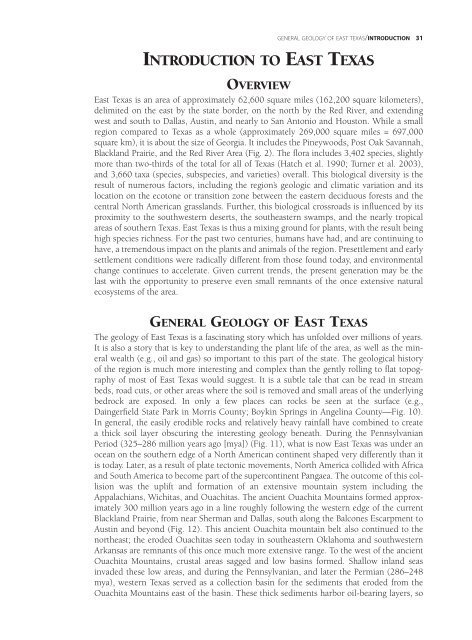ILLUSTRATED FLORA OF EAST TEXAS - Brit - Botanical Research ...
ILLUSTRATED FLORA OF EAST TEXAS - Brit - Botanical Research ...
ILLUSTRATED FLORA OF EAST TEXAS - Brit - Botanical Research ...
Create successful ePaper yourself
Turn your PDF publications into a flip-book with our unique Google optimized e-Paper software.
GENERAL GEOLOGY <strong>OF</strong> <strong>EAST</strong> <strong>TEXAS</strong>/INTRODUCTION 31<br />
INTRODUCTION TO <strong>EAST</strong> <strong>TEXAS</strong><br />
OVERVIEW<br />
East Texas is an area of approximately 62,600 square miles (162,200 square kilometers),<br />
delimited on the east by the state border, on the north by the Red River, and extending<br />
west and south to Dallas, Austin, and nearly to San Antonio and Houston. While a small<br />
region compared to Texas as a whole (approximately 269,000 square miles = 697,000<br />
square km), it is about the size of Georgia. It includes the Pineywoods, Post Oak Savannah,<br />
Blackland Prairie, and the Red River Area (Fig. 2). The flora includes 3,402 species, slightly<br />
more than two-thirds of the total for all of Texas (Hatch et al. 1990; Turner et al. 2003),<br />
and 3,660 taxa (species, subspecies, and varieties) overall. This biological diversity is the<br />
result of numerous factors, including the region’s geologic and climatic variation and its<br />
location on the ecotone or transition zone between the eastern deciduous forests and the<br />
central North American grasslands. Further, this biological crossroads is influenced by its<br />
proximity to the southwestern deserts, the southeastern swamps, and the nearly tropical<br />
areas of southern Texas. East Texas is thus a mixing ground for plants, with the result being<br />
high species richness. For the past two centuries, humans have had, and are continuing to<br />
have, a tremendous impact on the plants and animals of the region. Presettlement and early<br />
settlement conditions were radically different from those found today, and environmental<br />
change continues to accelerate. Given current trends, the present generation may be the<br />
last with the opportunity to preserve even small remnants of the once extensive natural<br />
ecosystems of the area.<br />
GENERAL GEOLOGY <strong>OF</strong> <strong>EAST</strong> <strong>TEXAS</strong><br />
The geology of East Texas is a fascinating story which has unfolded over millions of years.<br />
It is also a story that is key to understanding the plant life of the area, as well as the mineral<br />
wealth (e.g., oil and gas) so important to this part of the state. The geological history<br />
of the region is much more interesting and complex than the gently rolling to flat topography<br />
of most of East Texas would suggest. It is a subtle tale that can be read in stream<br />
beds, road cuts, or other areas where the soil is removed and small areas of the underlying<br />
bedrock are exposed. In only a few places can rocks be seen at the surface (e.g.,<br />
Daingerfield State Park in Morris County; Boykin Springs in Angelina County—Fig. 10).<br />
In general, the easily erodible rocks and relatively heavy rainfall have combined to create<br />
a thick soil layer obscuring the interesting geology beneath. During the Pennsylvanian<br />
Period (325–286 million years ago [mya]) (Fig. 11), what is now East Texas was under an<br />
ocean on the southern edge of a North American continent shaped very differently than it<br />
is today. Later, as a result of plate tectonic movements, North America collided with Africa<br />
and South America to become part of the supercontinent Pangaea. The outcome of this collision<br />
was the uplift and formation of an extensive mountain system including the<br />
Appalachians, Wichitas, and Ouachitas. The ancient Ouachita Mountains formed approximately<br />
300 million years ago in a line roughly following the western edge of the current<br />
Blackland Prairie, from near Sherman and Dallas, south along the Balcones Escarpment to<br />
Austin and beyond (Fig. 12). This ancient Ouachita mountain belt also continued to the<br />
northeast; the eroded Ouachitas seen today in southeastern Oklahoma and southwestern<br />
Arkansas are remnants of this once much more extensive range. To the west of the ancient<br />
Ouachita Mountains, crustal areas sagged and low basins formed. Shallow inland seas<br />
invaded these low areas, and during the Pennsylvanian, and later the Permian (286–248<br />
mya), western Texas served as a collection basin for the sediments that eroded from the<br />
Ouachita Mountains east of the basin. These thick sediments harbor oil-bearing layers, so
















